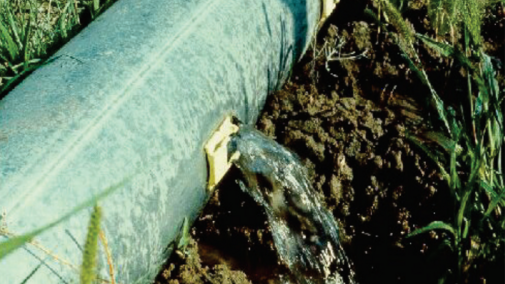Article reviewed and updated by Chuck Burr, Nebraska Extension Educator
Minimizing inefficiencies in gravity irrigation systems can save irrigators money and labor. Normal wear and tear associated with piecing together sections of irrigation pipe and opening and shutting gates can cause significant inefficiencies to irrigation over time.

Added profit: $32.10/acre
Based on elimination of two sets, 12 hr/set, 1000 g/m well, five irrigations/year, $10/ac-in pumped, $1.03/ac/yr to replace gates and gaskets.
Estimating Losses. Flow meters provide a method for estimating the amount of water that leaks from gates and gaskets. While leaks are not losses from the field, they do reduce the amount of water delivered to the set being irrigated. A Tri-Basin Natural Resource District study in the early 1990s showed that losses can exceed 50%. Often losses can be 20% to 30%, which is 5 to 6 gallons/minute per 30-foot length of pipe on most systems. A quarter mile length of pipe on a 1000 gallon/minute well would deliver only 750 gallons/minute to the set if the water loss is 25%.
Saving Water. The impact of losing 250 gallons/minute is shown in Table 1. The example simplifies calculations by using average set size, although number of gates per set is generally variable. It also assumes potential flow rate to be equal at both ends of the line, although actual field results will be different. The example depends on which set of gates are open, system design, and relative elevation from one end to another.
Saving Labor. Reducing leaks has added benefits that are not included in the suggested "added profit." Labor is an obvious major savings associated with fewer sets per irrigation. A value was not assigned to labor so you can use your own numbers on eliminating two trips to the field and the time associated with setting gates and checking rows.
Improving Water Quality. Another benefit can be improved ground water quality. Severe leakage can add a constant supply of water to one area for the duration of the irrigation. On silt-loam soils, one gallon per minute running down a row will only advance about 100 feet. If that loss were to occur uniformly along the pipeline, it would amount to about three acres along the pipe. If leaks continued for three days at a rate of 250 gallons/minute, 40 acre-inches per irrigation would be applied to about three acres of cropland. Estimates suggest that 5 pounds of nitrate move with every inch of water that leaches below the root zone (Watts). Continuous leaking has the potential to flush hundreds of pounds of nitrogen into the aquifer. Aside from contaminating the aquifer, it would take additional nitrogen to offset the loss, or acceptance of fewer bushels produced from those three acres.
| GPM Leaking | Well Output | GPM per Irrigated Furrow | Total Rows | Rows Per Irrigation Set | Number of Irrigation Sets Needed |
|---|---|---|---|---|---|
| 250 | 1000 | 15.6 | 1056 | 96 | 11 |
| 50 | 1000 | 16.2 | 1056 | 117 | 9 |
| Sets/Field | Set Time | Hours Pumped /Irrigation | Hours Pumped Per Year1 | Ac-in Pumped Per Year | Cost2 at $10/ac-in | Pumping Cost Per Acre | Cost of Repairs Per Acre3 | Dollars Saved4 |
|---|---|---|---|---|---|---|---|---|
| 11 | 12 | 132 | 660 | 1,458 | $14,580 | $182.25 | n/a | n/a |
| 9 | 12 | 108 | 540 | 1,193 | $11,930 | $149.12 | $1.03 | $32.10 |
|
1Assuming five irrigations per year. |
||||||||
Recommendations
- Flag leaky gaskets and mark leaky gates during the year to ensure repairs can be made in the off-season.
- Discard gaskets where flagged, as you pick up pipe at the end of the season. Some people carry gates with them and change damaged gates when they are found during the year. If that doesn't work for you, mark your calendar to replace gates after harvest.
A little labor in the off-season can pay big dividends when the demands for labor are great during the summer.
Resource
The Impact of Nitrogen and Irrigation Management and Vadose Zone Conditions on Ground Water Contamination by Nitrate-Nitrogen, Darrell Watts, University of Nebraska–Lincoln Extension Circular EC 91-735.

